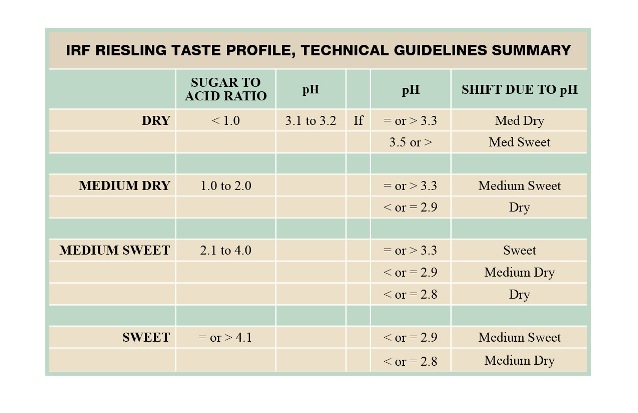If the label is IRF this is how its classified.
Riesling Sugar Guidelines: The Scale
The International Riesling Foundation supports four sweetness categories for Riesling, as set forth below, using no numbers to designate the various categories. They will be referenced only by the terms we used for each of the four categories.
Wineries are encouraged to use these categories on all their literature and labeling as well as verbally as a guide for wholesalers, retailers, restaurateurs and consumers.
In the following list, sugar and acid are listed in grams per liter.
Dry. All wines carrying this designation will have a sugar-to-acid ratio not exceeding 1.0. For example, a wine with 6.8 grams of sugar and 7.5 grams of acidity would be in the same category as a wine with 8.1 grams of sugar and 9.0 grams of acid. Similarly, a wine with 12 grams of sugar and 12 grams of acid would be classified as dry.
Notice also that wines that are totally or “near-totally” dry (such as 4 grams per liter) will have a much lower ratio. For instance, a wine with only 3 grams of sugar and a total acidity of 6 grams per liter will have a ratio of .5, and clearly the wine is dry.)
As to pH: we assume that the range of pHs for most Rieslings is between 2.9 and 3.4. So 3.1 is the “base” pH with which most wine makers will be working. So if the pH of wine is 3.1 or 3.2, it remains in this dry category. But if the pH is 3.3 or 3.4, it moves up to Medium Dry. (And if the pH is 3.5 or higher, the wine maker may wish to move the wine to Medium Sweet.)
Medium Dry. Here the ratio is 1.0 to 2.0 acid to sugar. Example: a wine with 7.5 grams of acid could have a maximum sugar level of 15.0 grams. And if the pH is above 3.3, it moves to Medium Sweet, and if the pH is as low as 2.9 or lower, the wine moves to Dry.
Medium Sweet. The ratio here is 2.1 to 4.0 acid to sugar. Example: a wine with 7.5 grams of acid could have a maximum sugar level of 30 grams. And again, the same pH factor applies as a level two wine: if the pH rises to 3.3, you move up to Dessert, and if the pH drops to 2.9 you move to Medium Dry. And if the pH is 2.8 or below (highly unlikely), the wine could be called Dry.
Sweet. Ratio above 4.1, but using the pH adjustment, a sweeter wine with a ratio of, say, 4.4 might actually be moved to Medium Sweet if the pH is significantly lower.
It is vital that all IRF members adhere to the same terminology so when we speak to Riesling consumers about what is a dry wine and what is a medium dry wine, we are all speaking the same language.
This guideline should assist restaurants in that servers can verbally tell patrons what style of wine they will be getting. The more it is used, the more the terminology will be understood.
It is highly recommended that this guideline be used in conjunction with the IRF’s approved graphic interpretation–the Riesling Taste Profile–which can be used on back labels, case cards, shelf-talkers, and so forth.



